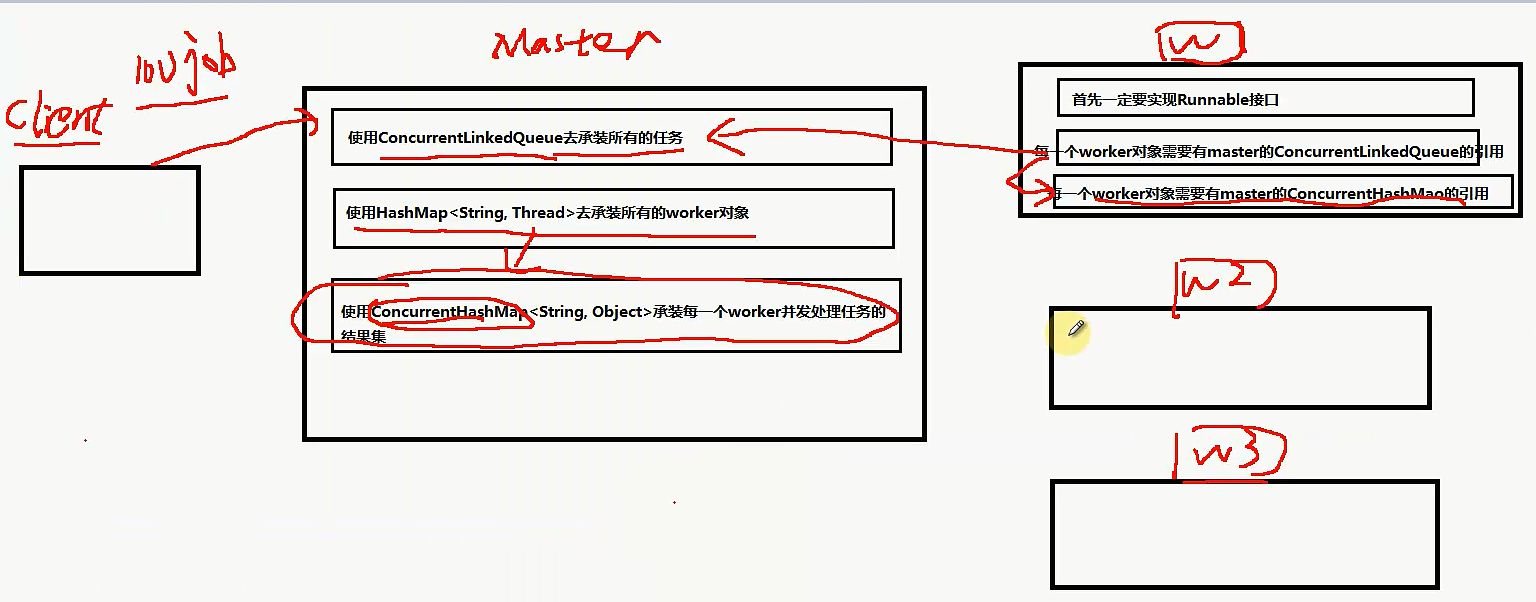Master和worker模式
让和hadoop的设计思想是一样的,Master负责分配任务和获取任务的结果,worker是真正处理业务逻辑的。
使用ConcurrentLikedQueue去承载所有的任务,因为会有多个worker会并发修改这个队列。

public class Task { private int id; private int price ; public int getId() { return id; } public void setId(int id) { this.id = id; } public int getPrice() { return price; } public void setPrice(int price) { this.price = price; } }
public class Master { //1 有一个盛放任务的容器 private ConcurrentLinkedQueue<Task> workQueue = new ConcurrentLinkedQueue<Task>(); //2 需要有一个盛放worker的集合 private HashMap<String, Thread> workers = new HashMap<String, Thread>(); //3 需要有一个盛放每一个worker执行任务的结果集合 private ConcurrentHashMap<String, Object> resultMap = new ConcurrentHashMap<String, Object>(); //4 构造方法 public Master(Worker worker , int workerCount){ worker.setWorkQueue(this.workQueue); worker.setResultMap(this.resultMap); for(int i = 0; i < workerCount; i ++){ this.workers.put(Integer.toString(i), new Thread(worker)); } } //5 需要一个提交任务的方法 public void submit(Task task){ this.workQueue.add(task); } //6 需要有一个执行的方法,启动所有的worker方法去执行任务 public void execute(){ for(Map.Entry<String, Thread> me : workers.entrySet()){ me.getValue().start(); } } //7 判断是否运行结束的方法 public boolean isComplete() { for(Map.Entry<String, Thread> me : workers.entrySet()){ if(me.getValue().getState() != Thread.State.TERMINATED){ return false; } } return true; } //8 计算结果方法 public int getResult() { int priceResult = 0; for(Map.Entry<String, Object> me : resultMap.entrySet()){ priceResult += (Integer)me.getValue(); } return priceResult; } }
public class Worker implements Runnable { private ConcurrentLinkedQueue<Task> workQueue; private ConcurrentHashMap<String, Object> resultMap; public void setWorkQueue(ConcurrentLinkedQueue<Task> workQueue) { this.workQueue = workQueue; } public void setResultMap(ConcurrentHashMap<String, Object> resultMap) { this.resultMap = resultMap; } @Override public void run() { while(true){ Task input = this.workQueue.poll(); if(input == null) break; Object output = handle(input); this.resultMap.put(Integer.toString(input.getId()), output); } } private Object handle(Task input) { Object output = null; try { //处理任务的耗时。。 比如说进行操作数据库。。。 Thread.sleep(500); output = input.getPrice(); } catch (InterruptedException e) { e.printStackTrace(); } return output; } }
public class Main { public static void main(String[] args) { Master master = new Master(new Worker(), 20); Random r = new Random(); for(int i = 1; i <= 100; i++){ Task t = new Task(); t.setId(i); t.setPrice(r.nextInt(1000)); master.submit(t); } master.execute(); long start = System.currentTimeMillis(); while(true){ if(master.isComplete()){ long end = System.currentTimeMillis() - start; int priceResult = master.getResult(); System.out.println("最终结果:" + priceResult + ", 执行时间:" + end); break; } } } }






【推荐】国内首个AI IDE,深度理解中文开发场景,立即下载体验Trae
【推荐】编程新体验,更懂你的AI,立即体验豆包MarsCode编程助手
【推荐】抖音旗下AI助手豆包,你的智能百科全书,全免费不限次数
【推荐】轻量又高性能的 SSH 工具 IShell:AI 加持,快人一步
· 10年+ .NET Coder 心语,封装的思维:从隐藏、稳定开始理解其本质意义
· .NET Core 中如何实现缓存的预热?
· 从 HTTP 原因短语缺失研究 HTTP/2 和 HTTP/3 的设计差异
· AI与.NET技术实操系列:向量存储与相似性搜索在 .NET 中的实现
· 基于Microsoft.Extensions.AI核心库实现RAG应用
· TypeScript + Deepseek 打造卜卦网站:技术与玄学的结合
· 阿里巴巴 QwQ-32B真的超越了 DeepSeek R-1吗?
· 【译】Visual Studio 中新的强大生产力特性
· 10年+ .NET Coder 心语 ── 封装的思维:从隐藏、稳定开始理解其本质意义
· 【设计模式】告别冗长if-else语句:使用策略模式优化代码结构